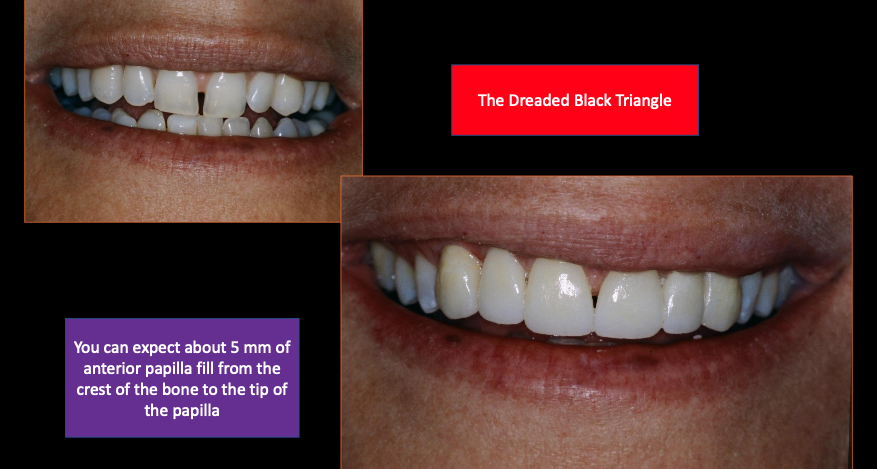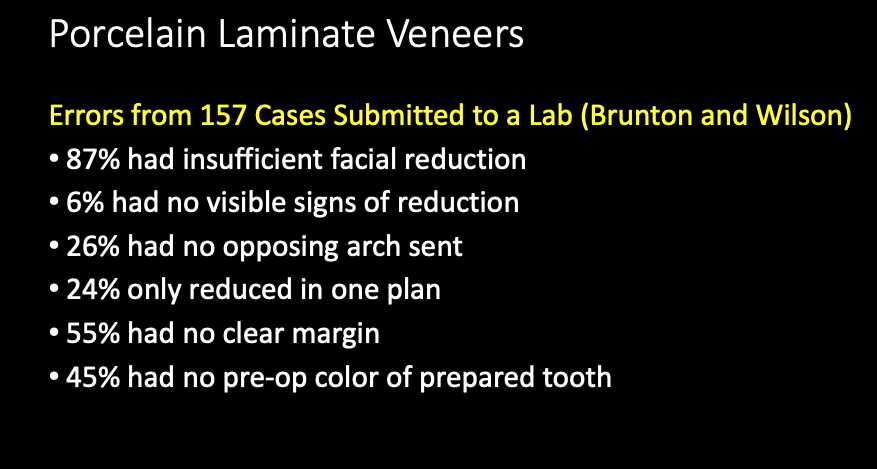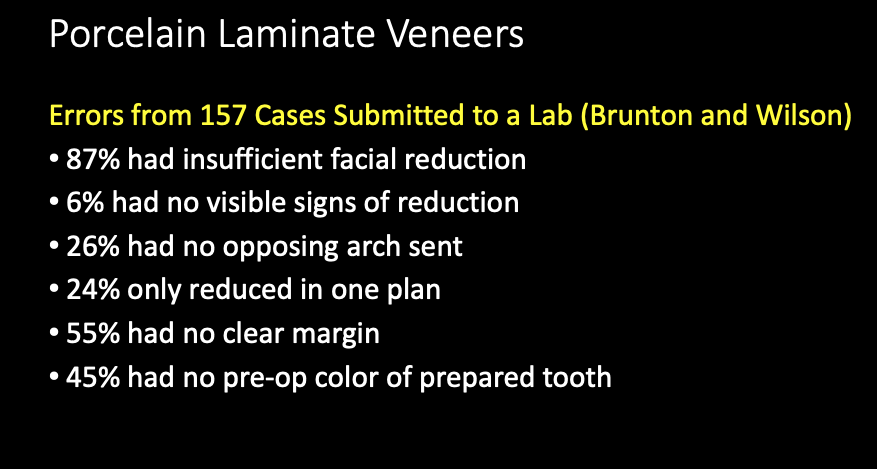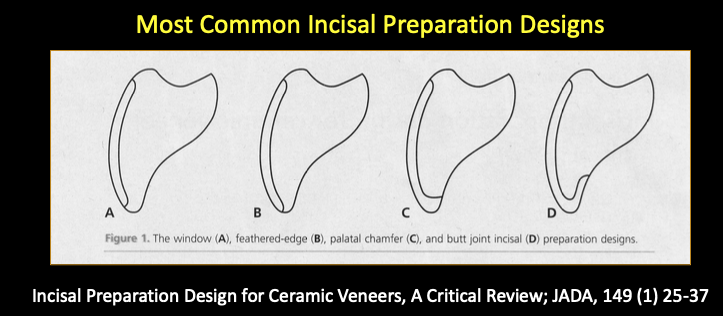3. Porcelain Laminate Veneers
0.0(0)
Card Sorting
1/46
Study Analytics
Name | Mastery | Learn | Test | Matching | Spaced |
|---|
No study sessions yet.
47 Terms
1
New cards
____ are the 1st string for rebuilding aesthetic smiles
Porcelain Laminate Veneers (PLV)
2
New cards
Primary use of PLVs
changing color and morphology of anterior teeth
3
New cards
What are some limitations of LPV’s
* occlusion
* designs and marginal placement
* quality of enamel
* designs and marginal placement
* quality of enamel
4
New cards
PLV indications
1. Discoloration resistant to bleaching
1. Tetracycline = most common
2. Modification of ant teeth
1. Diastemas, cone teeth, length
3. Rehab of ant teeth
1. fractures, congenital, malformations
5
New cards
Position and character of the _______ of central incisors/canines will determine the esthetics, phonetics, occlusal plane, anterior guidance and stability of the occlusion
incisal edges
6
New cards
PLV is best evaluated by a ________
diagnostic wax up
7
New cards
Why is prognosis poor on severely worn teeth?
* marginal placement = critical
* need adequate space for porcelain
* need adequate space for porcelain
8
New cards
Basic principles of PLV Preps
* Smooth uncomplicated preparation
* 0.3 - 0.5 mm enamel reduction...in 2-3
planes
* Smooth, adequate margins, soft
chamfer.
* Total margin in enamel
* Path of insertion from facial if possible
* Incisal edge covered with 1-1.5 mm of porcelain for esthetics and function
* Keep the tooth/veneer margin away from opposing incisal edges during maximum intercuspation
* The incisal preparation may or may not wrap to the lingual
* 0.3 - 0.5 mm enamel reduction...in 2-3
planes
* Smooth, adequate margins, soft
chamfer.
* Total margin in enamel
* Path of insertion from facial if possible
* Incisal edge covered with 1-1.5 mm of porcelain for esthetics and function
* Keep the tooth/veneer margin away from opposing incisal edges during maximum intercuspation
* The incisal preparation may or may not wrap to the lingual
9
New cards
PLV Prep Steps (3)
1. reduce incisal edge by 1-1.5 mm if needed
\
2. prepare facial surface in 2-3 planes, (if needed) remove an equal amount of tooth structure as determine by your diagnostic workup
\
3. define margins of the preparation and refine the margins with magnification to make them smooth
10
New cards
Depth orientation grooves at
1. Inicial/body
2. Gingival
\
Best burs?
1. Inicial/body
2. Gingival
\
Best burs?
1. 0.5
2. 0.3 mm
\
best burs: 1mm chamfer, Brassler-LVS1 (0.5mm) or LVS2 (0.3 mm) 3-wheel diamond depth cutter
11
New cards
Chamfer should be near the
gingival
12
New cards
T/F always break contact for PLVs
False
* depends
* depends
13
New cards
It is best to keep occlusal centric strikes _____ from restoration junction at lingual enamel
1 mm or more
14
New cards
advantages of an incisal overlap
1. Porcelain is stronger in ___ vs ______
\
2. Slight covering provides _____, aids in proper seating of veneer
\
3. Stress concentration of veneer diminishes, wide vertical stop to resist __________
1. Porcelain is stronger in ___ vs ______
\
2. Slight covering provides _____, aids in proper seating of veneer
\
3. Stress concentration of veneer diminishes, wide vertical stop to resist __________
1. compression vs tension
\
2. Vertical stop
\
3. Vertical loading
\

15
New cards
PLVs should be prepared in ____ planes on the facial surface.
\
List them
\
The purpose is that it allows for ___ path of insertion
\
List them
\
The purpose is that it allows for ___ path of insertion
3
\
1. Emergence
2. Midfacial
3. Incisal
\
\
Facial
* Bonding is stronger when enamel rods are 90 degrees
\
1. Emergence
2. Midfacial
3. Incisal
\
\
Facial
* Bonding is stronger when enamel rods are 90 degrees
16
New cards
What are some historical uses of provisionals? (5)
1. to protect the prepared teeth
2. as an esthetic replacement of teeth
3. to check occlusal function and stability
4. to keep the periodontium healthy
5. to evaluate phonetics and esthetics
17
New cards
T/F Digital impressions are great for PLVs
False - questionable
18
New cards
Best materials for PLV impressions
Polyether or Polyvinyl siloxane
19
New cards
What are some things that can effect shade selection?
1. Viewer
2. Shade guide/stump shade
3. Variable lighting
20
New cards
____ is critical to success of PLVs
Dry field isolation
21
New cards
1. The lab should apply the _____ before it come to you
\
2. Ideal to apply silane coupling agent before ____ this protects the etched surfaces during try-in and adjustment
3. Silane should be reapplied prior to ____
1. hydrofluoric acid
2. try in
3. cementation
22
New cards
____ is responsible for allowing HFA etching
Leucite
23
New cards
___coupling agents are thought to be active, forming ___ bonds with __ on the porcelain surface and increasing adhesion with ____
Silane
\
siloxane bonds with OH groups
\
porcelain surface and
\
composite
\
siloxane bonds with OH groups
\
porcelain surface and
\
composite
24
New cards
Silane should be exposed to porcelain for ______ *with a minimum of* ______
1 min
\
30 sec
\
30 sec
25
New cards
Silanation of porcelain before try-in seems to ______ the highly sensitive etched porcelain
protect and seal
26
New cards
Why is it important to properly store silane?
* Improperly sealed containers cause rapid evaporation of solvents
* Abused silane may act as a separating medium \n
* Abused silane may act as a separating medium \n
27
New cards
Describe bonding protocol:
1. Teeth are etched with __ phosphoric acid for *secs and rinsed with water for at least as long as* ____
\
2. Dry, according to manufacturer’s instructions...new generation agent
\
3. If dentin is exposed follow bonding protocol:
\
4. Apply __unfilled resin__ to veneer
\
5. Apply selected shade of luting agent to the
veneer and press gently onto the tooth
\
6. Carefully, remove expressed luting agent at the margins... photopolymerize with 5 mm tip for ___ secs remove cement with surgical blade with #12 or #15,
7. __ sec cure, wait for 20 sec,
\
8. then cure for __ min
1. Teeth are etched with __ phosphoric acid for *secs and rinsed with water for at least as long as* ____
\
2. Dry, according to manufacturer’s instructions...new generation agent
\
3. If dentin is exposed follow bonding protocol:
\
4. Apply __unfilled resin__ to veneer
\
5. Apply selected shade of luting agent to the
veneer and press gently onto the tooth
\
6. Carefully, remove expressed luting agent at the margins... photopolymerize with 5 mm tip for ___ secs remove cement with surgical blade with #12 or #15,
7. __ sec cure, wait for 20 sec,
\
8. then cure for __ min
1. 37%, for as long as it was etched
\
3. do not light cure unfilled resin (bonding agent)
6. 3 secs,
\
7. 20 secs
\
8. 1 min
28
New cards
Describe finishing steps
1. Remove excess cement w composite finishing knife, #12, or #15
2. Finish w diamond paste and polishing cups OR felt wheel if needed
29
New cards
why should you not use diamonds/carbide finishing burs on PLVs
they can ditch and deglaze surface
30
New cards
You can expect about ___ of anterior papilla filla from crest of bone to the tip of papilla
5 mm

31
New cards
what is the most common error submitted to labs?
insuff facial reduction

32
New cards
Increased fracture of porcelain when extending incisal edge more than ___
0\.5mm
33
New cards
at 5 years what was a common issue reported w PLVs?
Most had washed out luting agent at the margins, especially the gingival
\
even with dentinal bonding agents (always end in enamel)
\
even with dentinal bonding agents (always end in enamel)

34
New cards
Microleakage is assoc’d w what 2 things?
Dentinal bonding
\
lack of enamel
\
lack of enamel
35
New cards
Describe each of the types of fractures
* Static fracture line
* Cohesive fracture
* Adhesive Fracture
* Static fracture line
* Cohesive fracture
* Adhesive Fracture
* Static fracture line – fracture lines present but veneer intact on tooth
* (composite shrinkage and fatigue/occlusal loading)
* Cohesive fracture – incisal edge and gingival third
* (tensile force related, similar to abfraction related, flexing of teeth
\
* Adhesive failure – usually where not enough enamel is present or technique related failure
* (composite shrinkage and fatigue/occlusal loading)
* Cohesive fracture – incisal edge and gingival third
* (tensile force related, similar to abfraction related, flexing of teeth
\
* Adhesive failure – usually where not enough enamel is present or technique related failure
36
New cards
An _______ can be used to reduce failure
occlusal
37
New cards
1. Porcelain has been around for more than __ years in restorative dentistry
\
2. ___ Faunce and Meyers first described a laminate veneer restoration for incisors. The
porcelain was etched and bonded to enamel
1. 100
2. 1976
38
New cards
avg life of PLVs
10-12 years
39
New cards
Best chance for success is a fully equilibrated, __________
occlusion...particularly for lateral and protrusive excursions \n
occlusion...particularly for lateral and protrusive excursions \n
mutually protected
40
New cards
____ zone of enamel for best bonding of veneer to tooth structure
360 degree
41
New cards
Ideal Reduction Guidelines
1. Incisal
2. Ging margin
3. Facial
4. Planes
1. Incisal
2. Ging margin
3. Facial
4. Planes
1. 1-1.5 mm on incisal edge (if needed)
\
2. 0.3 mm chamfer at gingival margin
\
3. 0.5 mm reduction on most of facial surface
\
4. 2-3 planes on facial surface

42
New cards
Path of insertion should be from ______
Facial Incisal
\
\
\
\
43
New cards
When should contact be broken w LPVs
is diastema present
44
New cards
amount of reduction influenced by _____
diagnostic wax-up

45
New cards
Compare LPV materials
\
1. Feldspathic porcelains
\
2. Pressable ceramics
\
3. Pressable ceramics
\
1. Feldspathic porcelains
\
2. Pressable ceramics
\
3. Pressable ceramics
1. **Feldspathic porcelains** – hand stacked
\
2. **Pressable ceramics –**
1. Empress – leucite crystals help stop propagation of micro
cracks.
2. The occlusal wear of Empress is in the range of enamel.
3. Weakest of pressable ceramics but most natural and translucent.
4. It will not block out dark tooth structure
\
3. **Pressable ceramics –** E-Max (lithium disilicate) – combines high strength with high esthetics.
1. More opaque than Empress.
2. Wear about equal to enamel.
3. Can be adhesively or conventionally cemented
46
New cards
_____ failures can occur at any time over life of restoration.
Can occur in first few months when traumatic forces are present, or contamination occurred at insertion
Can occur in first few months when traumatic forces are present, or contamination occurred at insertion
Cohesive
47
New cards
T/F? Microleakage can sometimes be repaired but depends on area involved and how much
True